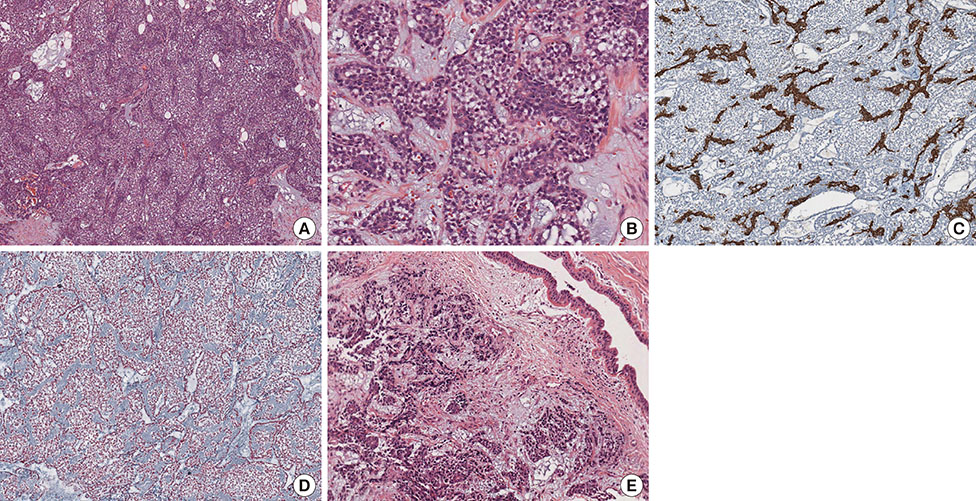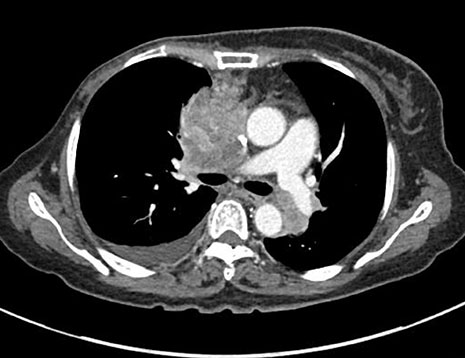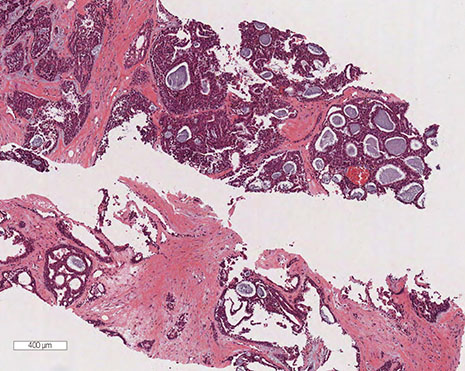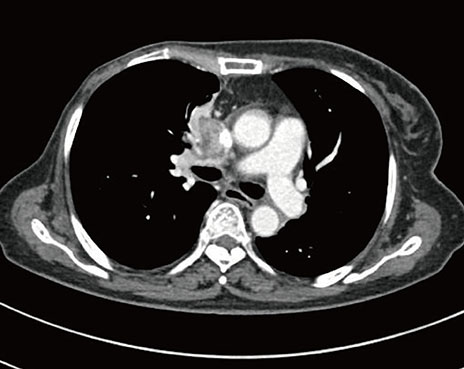J Breast Cancer.
2015 Dec;18(4):400-403. 10.4048/jbc.2015.18.4.400.
Malignant Adenomyoepithelioma of the Breast and Responsiveness to Eribulin
- Affiliations
-
- 1Department of Internal Medicine, Dong-A University College of Medicine, Busan, Korea. kimhj@dau.ac.kr
- 2Department of Pathology, Dong-A University College of Medicine, Busan, Korea.
- 3Department of Surgery, Dong-A University College of Medicine, Busan, Korea.
- KMID: 2176292
- DOI: http://doi.org/10.4048/jbc.2015.18.4.400
Abstract
- Adenomyoepithelioma (AME) of the breast is an uncommon tumor characterized by its dual differentiation into luminal cells and myoepithelial cells. In most cases these tumors have a benign clinical course, but distant metastases have been reported. We present the case of a 51-year-old woman diagnosed with malignant AME. The patient underwent a right modified radical mastectomy, and pathological examination confirmed the diagnosis of malignant AME. Ten months after the operation, multiple hepatic, pleural, and abdominal wall metastases were detected. A number of palliative chemotherapeutic agents were tried, including anthracycline and taxanes. However, the disease continued to progress, and superior vena cava syndrome developed as a result of direct tumor invasion. The patient received salvage eribulin monotherapy. After two cycles of this treatment, her clinical symptoms were ameliorated, and a computed tomography scan showed a partial response. Eribulin chemotherapy was thus effective in treating malignant AME in this case.
MeSH Terms
Figure
Reference
-
1. Hamperl H. The myothelia (myoepithelial cells): normal state; regressive changes; hyperplasia; tumors. Curr Top Pathol. 1970; 53:161–220.2. Loose JH, Patchefsky AS, Hollander IJ, Lavin LS, Cooper HS, Katz SM. Adenomyoepithelioma of the breast: a spectrum of biologic behavior. Am J Surg Pathol. 1992; 16:868–876.3. Simpson RH, Cope N, Skálová A, Michal M. Malignant adenomyoepithelioma of the breast with mixed osteogenic, spindle cell, and carcinomatous differentiation. Am J Surg Pathol. 1998; 22:631–636.
Article4. Michal M, Baumruk L, Burger J, Manhalová M. Adenomyoepithelioma of the breast with undifferentiated carcinoma component. Histopathology. 1994; 24:274–276.
Article5. Rasbridge SA, Millis RR. Adenomyoepithelioma of the breast with malignant features. Virchows Arch. 1998; 432:123–130.
Article6. Kihara M, Yokomise H, Irie A, Kobayashi S, Kushida Y, Yamauchi A. Malignant adenomyoepithelioma of the breast with lung metastases: report of a case. Surg Today. 2001; 31:899–903.
Article7. Hayes MM. Adenomyoepithelioma of the breast: a review stressing its propensity for malignant transformation. J Clin Pathol. 2011; 64:477–484.
Article8. Muñoz-Couselo E, Pérez-García J, Cortés J. Eribulin mesylate as a microtubule inhibitor for treatment of patients with metastatic breast cancer. Onco Targets Ther. 2011; 4:185–192.9. Cortes J, O'Shaughnessy J, Loesch D, Blum JL, Vahdat LT, Petrakova K, et al. Eribulin monotherapy versus treatment of physician's choice in patients with metastatic breast cancer (EMBRACE): a phase 3 open-label randomized study. Lancet. 2011; 377:914–923.
Article10. Ahmadi N, Negahban S, Aledavood A, Daneshbod K, Daneshbod Y. Malignant adenomyoepithelioma of the breast: a review. Breast J. 2015; 21:291–296.
Article11. Dewar R, Fadare O, Gilmore H, Gown AM. Best practices in diagnostic immunohistochemistry: myoepithelial markers in breast pathology. Arch Pathol Lab Med. 2011; 135:422–429.
Article12. Yoon JY, Chitale D. Adenomyoepithelioma of the breast: a brief diagnostic review. Arch Pathol Lab Med. 2013; 137:725–729.
Article13. Koyama M, Kurotaki H, Yagihashi N, Aizawa S, Sugai M, Kamata Y, et al. Immunohistochemical assessment of proliferative activity in mammary adenomyoepithelioma. Histopathology. 1997; 31:134–139.
Article14. Mastropasqua MG, Maiorano E, Pruneri G, Orvieto E, Mazzarol G, Vento AR, et al. Immunoreactivity for c-kit and p63 as an adjunct in the diagnosis of adenoid cystic carcinoma of the breast. Mod Pathol. 2005; 18:1277–1282.
Article15. Cortes J, Vidal M. Beyond taxanes: the next generation of microtubuletargeting agents. Breast Cancer Res Treat. 2012; 133:821–830.
Article





